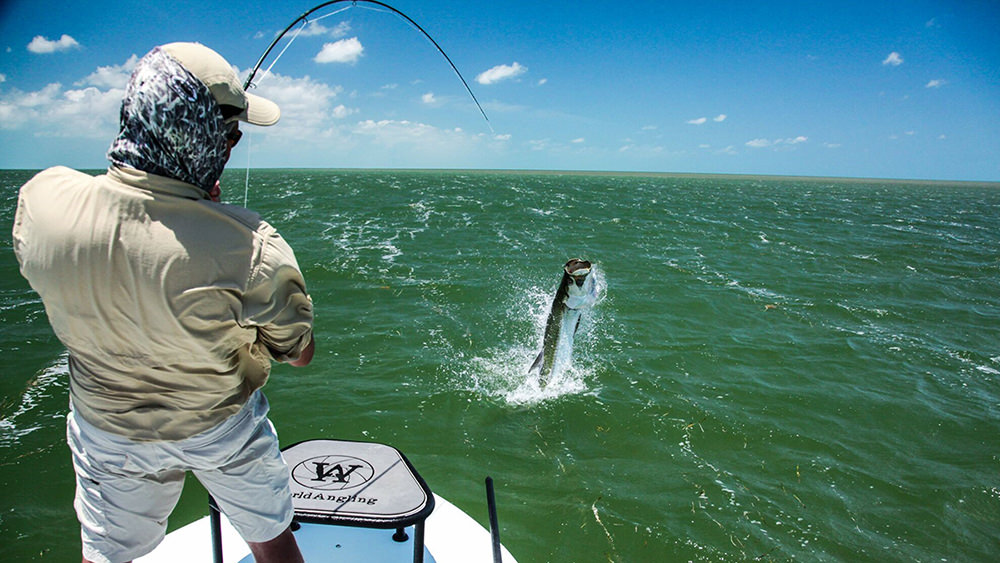
by Rick O'Connor | Aug 18, 2021
This is a famous fish. If you look back at the old tourism magazines of the early 20th century you will see a lot about tarpon fishing in Florida. As a matter of fact, some say that tarpon fishing was the beginning of the tourism industry in the state. Also known as “silver kings”, they put up a tremendous fight which anglers love, particularly on lighter tackle. It is a sport fish, not sought for food, so catch and release has been the rule for years. But those who seek them will tell you it is worth the fight even if you must release it.

Tarpon have been a popular fishing target for decades.
Photo: NOAA
Tarpon (Megalops atlantica) are large bodied, large scaled fish, with a deep blue back and silver sides. They are a large fish, reaching over 8 feet in length and up to 350 pounds. They tend to travel in schools and are often associated with other fish, such as snook2.
It has always been thought of as a “south Florida fish”. As mentioned, down there it is a popular fishing target for tourist and residents alike. Many charter captains specialize in catching the fish and they have been featured in fishing programs. But you do not hear about such things in the Florida panhandle. Hoese and Moore1, as well as the Florida Museum of Natural History2 both indicate that they are in fact in the Florida panhandle. As a matter of fact, this fish has few barriers and has the distribution of the classic “Carolina fish” group. That includes the entire eastern seaboard of the United States, the entire Gulf of Mexico, and the Caribbean1. The Florida Museum of Natural History indicates they are found on the opposite shores of the Atlantic Ocean and may have made their way through the Panama Canal to the Pacific shores of the canal. Within this range they are known to enter freshwater rivers. They seem to have few biogeographic barriers.
I grew up in the panhandle and remember hearing about them swimming in our area when I was younger. Fishermen said they would throw all sorts of bait at them. Artificial lures, live bait, cut bait, you name it – they tossed it… the tarpon never would take it. Catching one here was almost impossible. The flats fishing charter trips for tarpon in south Florida would not happen here. I remember once diving in Pensacola Bay near Ft. Pickens. We were looking for an old Volkswagen beetle that had been sunk years ago when at one point the water became very dark – almost like storm clouds had rolled in. When my buddy and I both looked up we saw a school of very large fish swimming above us. We were not sure what they were at first but as we slowly ascended, we realized they were tarpon. It was pretty amazing.
An interesting side note here. In 2020 tarpon were once again seen swimming around the Pensacola area but this time they WERE taking bait. There were several reports of tarpon caught off the Pensacola Fishing Pier and inside the bay. Why change over all this time? I am not sure.

The ladyfish (or skipjack) is the smaller cousin of the tarpon, but puts up a good fight as well.
Photo: University of Southern Mississippi
Tarpon belong to the family Elopidae which also includes another local fish known as the “ladyfish” or “skipjack” (Elops saurus). This is a much smaller fish reaching about 3 feet (and that would be a large ladyfish). The scales of this family member are much smaller, but the fight on hook and line is just as large. The characteristic that places these two fish into the same family (and these are the only two in this family) is the hard bony gular plate found between the right and left side of the lower jaw (in the “throat” area).
Like tarpon, it is not prized as a food fish but more of a game fish. It has the classic wide distribution of the “Carolina fish group” – the eastern seaboard of the United States, the Gulf of Mexico, down to Brazil. Like the tarpon, it is found in brackish conditions but is not mentioned in freshwater. Again, few biogeographic barriers for this fish.
Both members of this family provide anglers young and old with a lot of enjoyment.
1 Hoese, H.D., R.H. Moore. 1977. Fishes of the Gulf of Mexico; Texas, Louisiana, and Adjacent Waters. Texas A&M Press, College Station TX. Pp. 327.
2 Discover Fishes. Tarpon. Florida Museum of Natural History. https://www.floridamuseum.ufl.edu/discover-fish/species-profiles/megalops-atlanticus/.
3 Discover Fishes. Ladyfish. Florida Museum of Natural History. https://www.floridamuseum.ufl.edu/discover-fish/species-profiles/elops-saurus/.
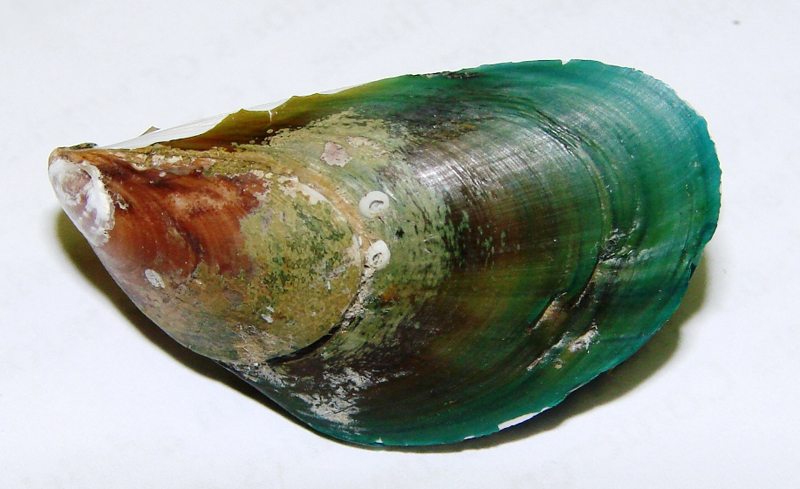
by Rick O'Connor | Aug 11, 2021
EDRR Invasive Species
Green Mussel (Perna viridis)
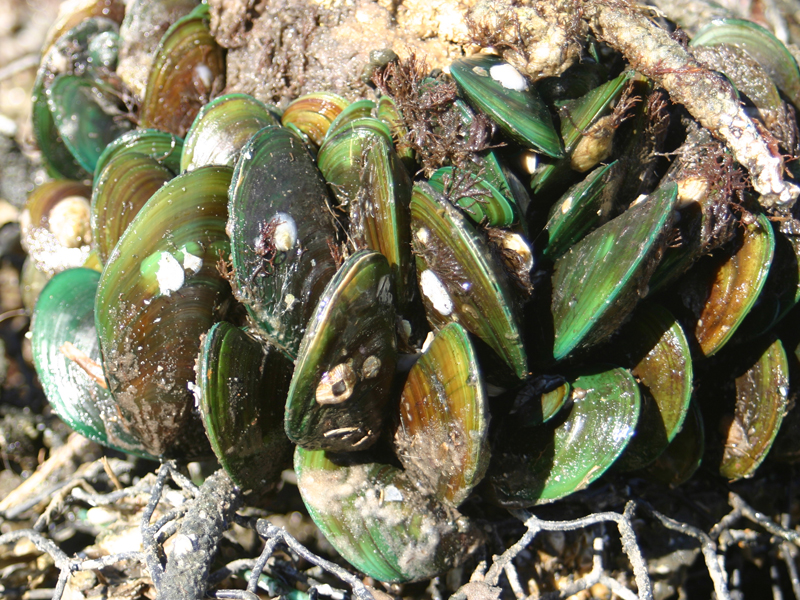
This cluster of green mussels occupies space that could be occupied by bivavles like osyters.
Define Invasive Species: must have ALL of the following –
- Is non-native to the area, in our case northwest Florida
- Introduced by humans, whether intentional or accidental
- Causing either an environmental or economic problem, possibly both
Define EDRR Species: Early Detection Rapid Response. These are species that are either –
- Not currently in the area, in our case the Six Rivers Cooperative Invasive Species Management Area (CISMA), but a potential threat
- In the area but in small numbers and could be eradicated
Native Range:
Green mussels are native to the Indo-Pacific region extending from India to Southeast Asia.
Introduction:
Green mussels have been cultivated as an aquaculture product and were introduced to other parts of the world as such. They were first reported growing wild in the waters of the Caribbean in the 1990s reaching Venezuela by 1993. The first report in Florida was in the Tampa Bay region in 1999. They have been slowly dispersing south along Florida’s Gulf coast. In 2003 they were found on the Atlantic coast near Crescent Beach and the Jacksonville-St. Augustine area. That same year a few single specimens were collected off the coast of Georgia and by 2006 there were records in Charleston SC. There are only a couple records from the Florida panhandle. In 2008 a couple of specimens were reported in the Panama City area and one record in 2011 came from Perdido Key (this one may have been misidentified).
EDDMapS currently list 128 records of green mussels in the U.S. All 128 are from the state of Florida, though the USGS reports one from the state of Washington. There is only one record within the Six Rivers CISMA (that from Pensacola Bay region).
Description:
Mussels are sessile bivalves attached to the substrate using thin byssal threads. This is a large mussel, reaching lengths of 3-4” and some up to 6”. Its shell is not ribbed like our native ribbed mussel often found in salt marshes, but rather smooth and possesses a brilliant emerald green color. In larger/older individuals the green is found more on the margins of the shell with the rest taking on a brownish coloration. The inside of the shell resembles our native mussel in having a bluish iridescent coloration.
Issues and Impacts:
The primary issue with green mussels is fouling. Like zebra mussels, green mussels can foul boat bottoms, overgrow on marina pilings, and clog intake pipes for water treatment and power plant facilities. They can clog crab traps, shellfish aquaculture bags, and will displace native species such as oysters – making oyster restoration projects harder. There is evidence of predation by blue crab and sheepshead, but there does not seem to be enough predation to control populations where they are currently found.
Management:
First, check your boat hull and bilge water before trailering to another water body. It is recommended that you scrap the hull and empty your bilge on land so as not to provide any live material entering the waterways. Be sure you are removing at a location at the ramp where the animals, or even sections of the animals that may contain gametes, cannot reach the waterways during a rain event or other run-of situation.
Second, if found on a seawall or piling, use a paint scraper or flat shovel to remove from such. You want to collect AS MUCH MATERIAL AS YOU CAN into a 5-gallon bucket and remove from the water system. Again, any gamete material remaining could continue the population. At this point you can allow them to dry out and then dispose of.
Third, if in intake pipes there are several methods to remove but many are expensive and options depend on the system that is fouled. It is recommended that you contact your county extension office for advice.
In either case, it is important to report the record to EDDMapS – https://www.eddmaps.org/.
For more information on this EDRR species, contact your local extension office.
References
Dr. Shirley Baker, University of Florida, personal communication.
McGuire, M., J. Stevely. 2018. Invasive Species of Florida’s Coastal Waters: The Asian Green Mussel (Perna viridis). University of Florida IFAS Electronic Data Information System (EDIS). https://edis.ifas.ufl.edu/publication/SG094.
United States Geological Survey. Nonindigenous Aquatic Species Series. Green Mussel (Perna viridis). https://nas.er.usgs.gov/queries/FactSheet.aspx?speciesID=110.
Early Detection and Distribution Mapping System (EDDMapS)
https://www.eddmaps.org/
Six Rivers CISMA
https://www.floridainvasives.org/sixrivers/
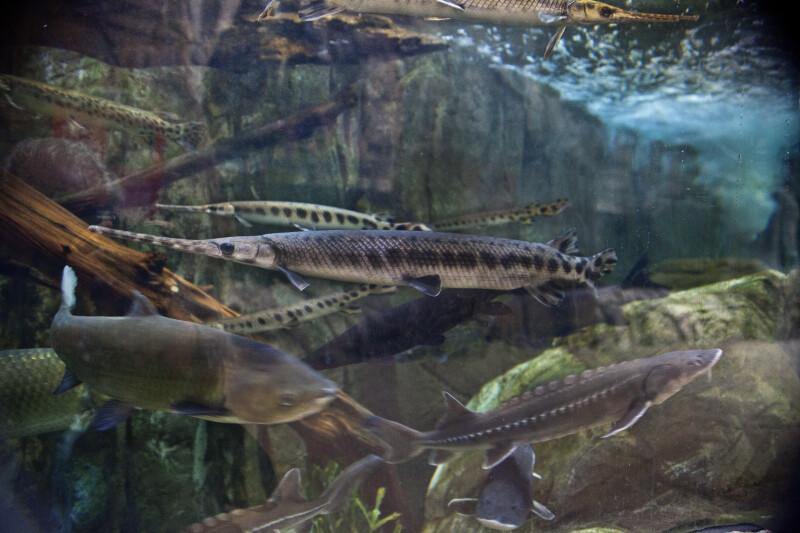
by Rick O'Connor | Aug 8, 2021
Like the ancient sturgeon, this is one strange prehistoric looking group of fish. I’ll say group of fish because there is more than one kind. For many, all gars are alligator gars. There is an alligator gar but there are others. Actually, the longnose gar may be seen more often than the alligator gar, but many do not know there is more than one kind.
Gars are freshwater fish, but several species have a high tolerance for saltwater. The alligator gar (Artactosteus spatula) has been reported from the Gulf of Mexico1. They are elongated, slow moving fish with extended snouts full of sharp teeth – very intimidating to look at. But swimming with gars in springs and rivers, I have found them to be oblivious to me. Snag one in a net however, and they will turn quickly and could do serious harm. While fishing my grandson had one come after his bait once and that was pretty exciting, but it is rare to catch them on hook and line. Many who fish for them do so with bow and arrow. Their skin is covered with tough ganoid scales. You really can’t scale them; you have to skin them.
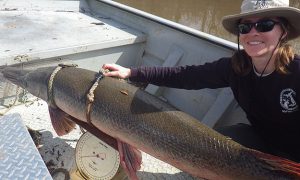
Alligator Gar from the Escambia River.
Photo: North Escambia.com
In the book Fishes of the Gulf of Mexico, by Hoese and Moore, they list four species of gar in the northern Gulf. As the name suggests, the longnose gar (Lepisosteus osseus) has a long slender snout and has spots on the body. It is the one most often seen by people visiting our springs, rivers, and the one most often seen in our estuaries. It can reach a length of five feet3.
The famous alligator gar (Artactosteus spatula) has a shorter snout and spots are usually lacking. If they do have them, the are usually on the fins. This is a big boy – reaching lengths of nine feet and up to 100 pounds2. They are common in coastal estuaries and even the Gulf, though not encountered very often.
The spotted gar (L. oculatus) also has a short snout but has spots all over its body. It prefers the rivers and will enter estuaries only where the salinities are low. It is smaller at four feet4.
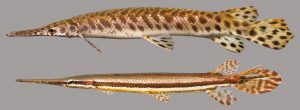
Spotted Gar.
Photo: University of Florida
The last panhandle gar is the shortnose gar (L. platostomus). This species too prefers rivers and may enter low salinity bays. It has a short snout and lacks spots.
There is a Florida gar (L. platyrhincus) not found in the panhandle but exists along the central and south Florida gulf coast. It seems to have replaced the spotted gar in this location5.
The biogeography of this group of fish is interesting in that it is an ancient like the sturgeon, it existed during a time period when much of Florida would have been underwater. The general range of gars is the entire eastern United States. They prefer slow moving rivers, or backwaters of faster rivers, and are common in springs. As mentioned, a few species will venture into saltwater and can be found around the Gulf of Mexico. But with several species there has obviously been some speciation over time.
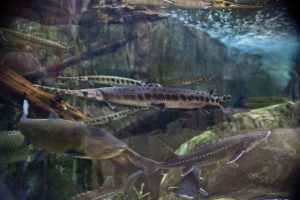
The common longnose gar.
Photo: University of South Florida.
The longnose gars have one of the widest distributions within the group. They are found in most river systems across the eastern United States and all of Florida. It seems to have few barriers including saltwater.
Alligator gars have a similar distribution but seem to be restricted from the peninsula part of Florida. The Florida rivers where they are found are all in the panhandle and are all alluvial rivers – muddy and not tannic like the Suwannee. This could be due to required food that prefer alluvial rivers, pH (pH is lower in the tannic rivers), or something else. Though they did not disperse into central and south Florida, they did extend their range westward down into Mexico. And, as mentioned, have been reported in the open Gulf of Mexico.
Spotted gars follow a similar distribution to the alligator gar. Much of the Mississippi River basin, Florida panhandle, and west to Texas – but they are not found in peninsular Florida. Pre-dating the emergence of peninsular Florida from the sea, there was some barrier that prevented them from dispersing south when the landmass did appear.
A different species appeared in peninsular Florida along with the longnose gar – the Florida gar. It is found in central and south Florida and has dispersed a little north along the Atlantic coast to Georgia.
This is an interesting group of ancient fish. Some are commercially harvested and have suffered from human alterations of river systems. They are amazing to see.
1 Hoese, H.D., R.H. Moore. 1977. Fishes of the Gulf of Mexico; Texas, Louisiana, and Adjacent Waters. Texas A&M Press, College Station TX. Pp. 327.
2 Discover Fishes. Florida Museum of Natural History. Alligator Gar. https://www.floridamuseum.ufl.edu/discover-fish/florida-fishes-gallery/alligator-gar/.
3 Discover Fishes. Florida Museum of Natural History. Longnose Gar. https://www.floridamuseum.ufl.edu/discover-fish/florida-fishes-gallery/longnose-gar/.
4 Discover Fishes. Florida Museum of Natural History. Spotted Gar. https://www.floridamuseum.ufl.edu/discover-fish/florida-fishes-gallery/spotted-gar/.
5 Discover Fishes. Florida Museum of Natural History. Florida Gar. https://www.floridamuseum.ufl.edu/discover-fish/florida-fishes-gallery/florida-gar/.
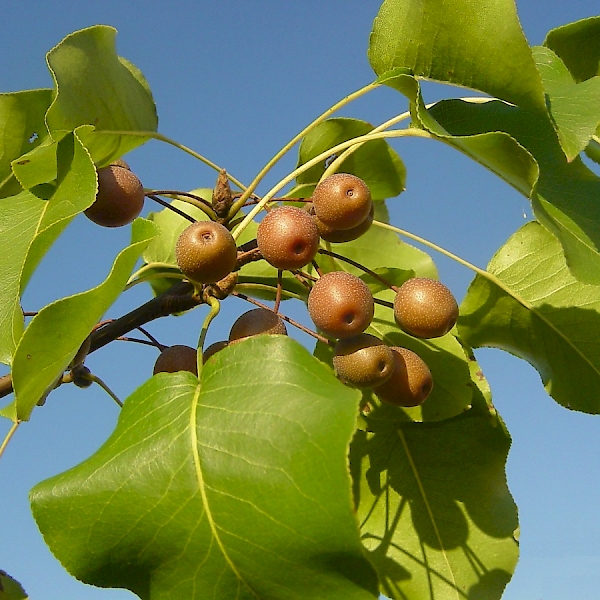
by Rick O'Connor | Jul 27, 2021
Six Rivers “Dirty Dozen” Invasive Species
Callery Pear – Bradford Pear (Pyrus calleryana)

Callery Pear
Photo: University of Florida IFAS
Define Invasive Species: must have all of the following –
- Is non-native to the area, in our case northwest Florida
- Introduced by humans, whether intentional or accidental
- Causing either an environmental or economic problem, possibly both
Define “Dirty Dozen” Species:
These are species that are well established within the CISMA and are considered, by members of the CISMA, to be one of the top 12 worst problems in our area.
Native Range:
Korea and China
Introduction:
The Callery Pear was introduced to the United States in the early 1900s intentionally as an ornamental plant. Its fruits were sterile because they do not self pollinate and spreading was not an issue. New cultivars were produced to reduce the tendency of the tree to split when covered with snow, or in high winds. The ‘Bradford’, and other cultivars, have hybridized with the Asian Pear (P. betulifolia) and produced fertile fruit that have spread into natural areas and become an ecological problem.
EDDMapS currently list 6,112 records of this plant spread across the United States. 1,837 are listed in the southeastern United States and 164 of those are in Florida. All 164 are found within the Six Rivers CISMA in Santa Rosa and Okaloosa counties. It is most likely under reported.
Description:
It is a tree that can reach 50 feet in height. It grows very quickly and the branches are close together forming a dense round-ish canopy. The leaves are glossy, simple, ovate in shape, serrated on the edges, and alternate on the branch. It is a deciduous and will turn all sorts of colors in the fall. It produces a beautiful white blossom tinged in pink. It does produce an aroma that some find unpleasant. The fruits are round, about 0.5-1.0” in diameter, and golden brown in color. The bark is dark to light brown in color and very smooth to the touch.
Issues and Impacts:
The primary issue with the Bradford cultivar is the ecological problems it has caused in natural areas. The University of Florida IFAS Assessment considers it a high risk as an invasive species.
Management:
Trees should be cut down and stumps treated with either glyphosate or triclopyr products. Multiple treatments will be needed.
For more information on this Dirty Dozen species, contact your local extension office.
References
Callery (Bradford) Pear. Invasive Plant Atlas of the United States. https://www.invasiveplantatlas.org/subject.html?sub=10957.
Early Detection and Distribution Mapping System (EDDMapS)
https://www.eddmaps.org/
Gilman, E.F., D.G. Watson, R.W. Klein, A.K. Koeser, D.R. Hilbert, D.C. McClean. Pyrus calleryana, “Bradford” Callery Pear. University of Florida Electronic Data Information System publication.
https://edis.ifas.ufl.edu/pdf/ST/ST53700.pdf.
Six Rivers CISMA
https://www.floridainvasives.org/sixrivers/
University of Florida IFAS Assessment
https://assessment.ifas.ufl.edu/assessments/pyrus-calleryana/
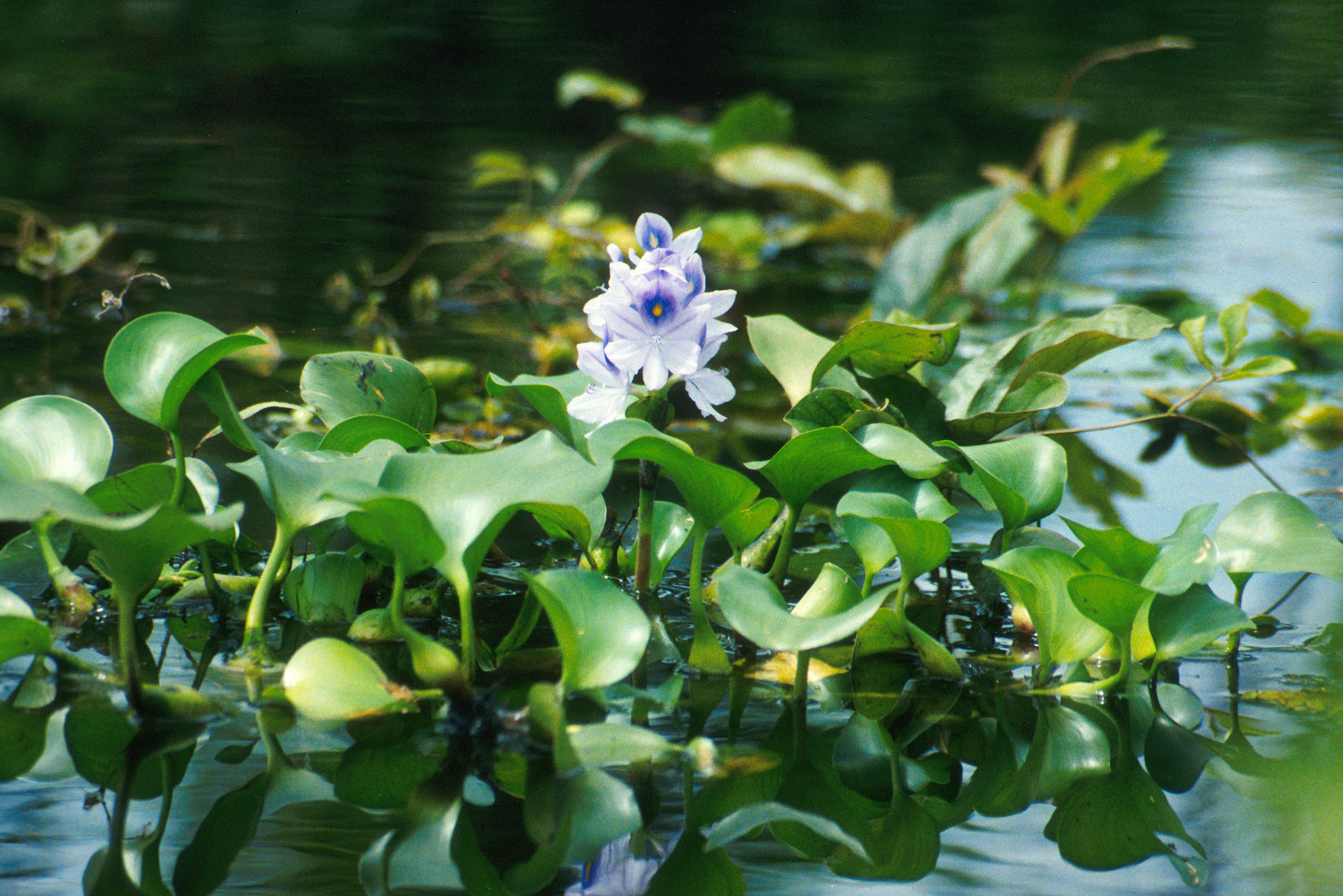
by Rick O'Connor | Jul 22, 2021
EDRR Invasive Species
Water Hyacinth (Eichhornia crassipes)
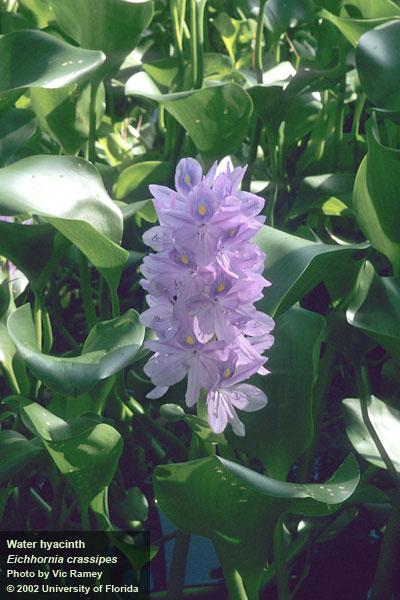
Water Hyacinth Photo Credit: Vic Ramey, UF/IFAS
Define Invasive Species: must have ALL of the following –
- Is non-native to the area, in our case northwest Florida
- Introduced by humans, whether intentional or accidental
- Causing either an environmental or economic problem, possibly both
Define EDRR Species: Early Detection Rapid Response. These are species that are either –
- Not currently in the area, in our case the Six Rivers CISMA, but a potential threat
- In the area but in small numbers and could be eradicated
Native Range:
Water hyacinth is native to South America.
Introduction:
It was introduced intentionally by horticulturists in 1884 at the Cotton States Exposition in New Orleans.
EDDMapS currently list 15,051 records of water hyacinth in the U.S. These records are scattered across the country with over 12,000 coming from the state of California. There are 1,229 reported from the southeastern U.S., which is certainly under reported, and 784 in Florida, also under reported – though resource managers indicate that amount of water hyacinth in Florida has decreased with management efforts. There are 13 records reported from the Six Rivers CISMA. This is assumed to be under reported but suggest the plant is correctly listed as an EDRR species and spread could be stopped. Three are from the Mobile delta area, one from Fairhope AL, and the remaining in Okaloosa County.
Description:
This is a perennial free floating freshwater aquatic plant, with long dark roots. The leaves form rosettes and the petioles can be 12” in length. They are bulbous and inflated, particularly near the base. The leaves are a deep green and glossy looking. They can be six inches wide and elliptic in shape.
The flowers extend above the rosette. They are lavender and blue with a flash of yellow. The flower can be 12” tall and 2” across.
Issues and Impacts:
The plant can form extremely dense floating mats making boating, fishing, or any other water recreation impossible. These dense mats can inhibit the growth of other native plants, reducing certain aquatic animals, and overall decreasing biodiversity. The mats reduce air-water oxygen exchange reducing dissolved oxygen as well as block sunlight reducing the development of many submerged aquatic vegetation. Again, reducing the systems overall biodiversity.
Management:
Small patches in local ponds and lakes can easily be removed by hand.
For large infestations there are large mechanical mowers/choppers that can be used to remove from the waterway. The remains can be further chopped and disposed of.
There are herbicides that can be used but these must be ones approved by both the U.S. EPA and FDACS for use in aquatic systems. The labels will state this. It is illegal to do so otherwise. Care should be taken when selecting herbicides for aquatic use considering other important aquatic plants and toxicity to aquatic animals such as fish. Diquat is considered an excellent choice. Carfentrazone and copper are considered fair. Others are not recommended. NOTE: these herbicides do not always completely eradicate the plant and windy conditions can make treatments a problem. The EDIS publication referenced below is a helpful resource to begin review of chemical treatment, and you can always contact your county extension office for more advice before using aquatic herbicides.
For more information on this EDRR species, contact your local extension office.
References
Water Hyacinth, Eichhornia crassipes
University of Florida IFAS Center for Aquatic and Invasive Plants
https://plants.ifas.ufl.edu/plant-directory/eichhornia-crassipes/
Efficacy of Herbicide Active Ingredients Against Aquatic Weeds.
Enloe, S.F., M.D. Netherland, W. Haller, and K. Langeland.
University of Florida IFAS Electronic Data Information Service (EDIS)
https://edis.ifas.ufl.edu/publication/ag262.
Early Detection and Distribution Mapping System (EDDMapS)
https://www.eddmaps.org/
Six Rivers CISMA
https://www.floridainvasives.org/sixrivers/











